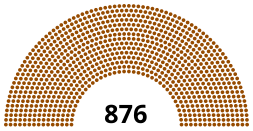This article needs additional citations for verification. (March 2020) |
Greater German Reichstag Großdeutscher Reichstag | |
|---|---|
| Legislative body of Germany | |
 | |
| Type | |
| Type | |
| History | |
| Established | 23 March 1933 |
| Disbanded |
|
| Preceded by | Weimar Reichstag |
| Succeeded by | |
| Leadership | |
| Structure | |
| Seats | 876 (at dissolution)[1] |
 | |
Political groups | Nazi Party (876) |
| Elections | |
| Plebiscitary show elections | |
First election | November 1933 |
Last election | 4 December 1938 |
| Meeting place | |
 | |
| Kroll Opera House, Berlin | |
| Constitution | |
| Constitution of the German Reich (de jure) | |
The Reichstag ("Diet of the Realm"),[2] officially the Greater German Reichstag (German: Großdeutscher Reichstag) after 1938, was the national parliament of Nazi Germany from 1933 to 1945. Following the Nazi seizure of power and the enactment of the Enabling Act of 1933, it functioned purely as a rubber stamp for the actions of Adolf Hitler's dictatorship — always by unanimous consent — and as a forum to listen to Hitler's speeches. In this purely ceremonial role, the Reichstag convened only 20 times, the last on 26 April 1942. The President of the Reichstag (Reichstagspräsident) throughout this period was Hermann Göring.
During this period, the Reichstag was sometimes derisively referred to by the German public as the "teuerste Gesangsverein Deutschlands" (the most expensive singing club in Germany) due to frequent singing of the national anthem during sessions. To avoid holding scheduled elections during World War II, in 1943 Hitler extended the term of office of the current Reichstag (elected in late 1938 to serve in 1939–1943) to serve a special eight-year term to end on 30 January 1947.